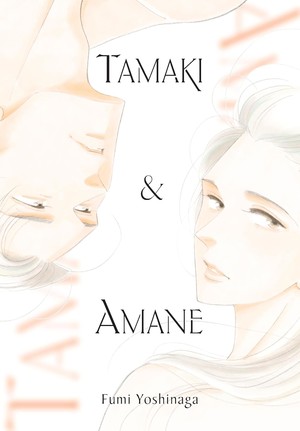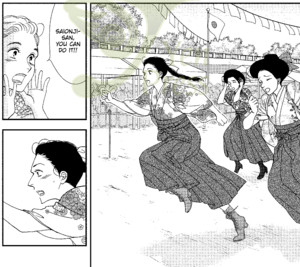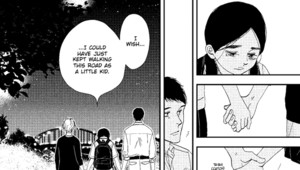The Spring 2025 Manga Guide
Tamaki & Amane
What's It About?

Tamaki & Amane has a story and art by Fumi Yoshinaga, with English translation by Taylor Engel. This volume is lettered by Adnazeer Macalangcom. Published by Yen Press (April 22, 2025). Rated T.
Content warning: this volume contains depictions of child abuse and neglect.
Is It Worth Reading?
Rebecca Silverman
Rating:

Taking place across five different periods, Fumi Yoshinaga's Tamaki & Amane is further proof that the creator of Ōoku: The Inner Chambers is just as good at literary fiction as she is at genre fiction. Since her name is still, for some readers, firmly associated with BL, that's worth mentioning, although I'd argue that any of her works are easily enjoyed by anyone who likes a well-written and well-drawn manga. In any event, Tamaki & Amane more than fit that description.
Opening in the modern day and ending (not counting the epilogue) in the Edo period, the story follows two people named Tamaki and Amane through different lives. Whether they're two Meiji Era schoolgirls, two soldiers in post-WWII Tokyo, an adult and a child in 1977, or a married couple or star-crossed lovers, each chapter (effectively a short story) explores their dynamic together. Each story also has its own genre flavor as well – chapter two, the Meiji Era one, has the feel of classic lesbian fiction from the early twentieth century, such as Nobuko Yoshiya's The Yellow Rose, while the fourth chapter, about two soldiers in the immediate aftermath of WWII, reads like a drama. More importantly, only the first story, set in the present day and continuing into the epilogue, features Amane and Tamaki firmly together, something explained by the fifth chapter, which takes place during the Edo period.
While the book as a whole is exploring the idea of fate and working off one's karmic debt (or bad luck, if you prefer), it also reads like a nuanced relationship study. Amane of 1977, a nurse dying of an unspecified terminal illness, is searching for a way to feel less alone when she meets Tamaki of that era, a kindergarten-aged child. Their relationship is fundamentally different from when Sergeant Tamaki and Private Amane meet during the war and again after it, although all of the variations of the characters exemplify, in some way, the idea of yearning. Interestingly, it is the two from the most distant pasts that showcase that most clearly, which feels like Yoshinaga leaning into the hazy beauty of days gone by.
As always, Yoshinaga's art is delicate and exquisite. We get a real feel for each time and place, with the 1977 chapter standing out as particularly rooted in its era; we can guess the year based on the background details in the artwork as well as the references dropped. Taylor Engel's translation captures the feel of each period in the dialogue as well, while never resorting to the infamous Elizabethan tone of Ōoku's English translation. This is simply a beautiful book.
Lauren Orsini
Rating:

Fumi Yoshinaga must be stopped. After her sweeping historical sci-fi drama Ōoku: The Inner Chambers tore my heart out, and her simple slice of life What Did You Eat Yesterday? moved me to tears, I should have had my guard up for Tamaki and Amane. It's just a series of five loosely-connected short comics, how bad could it be? Too late, I already had tears in my eyes by the end of the first story. A literary fiction about the chance tender connections between multiple people who all happen to be named Tamaki or Amane, this manga's gentle art, ear for dialogue, and focus on the ordinary dramas of daily life ruthlessly left me for dead.
The stories of Tamaki and Amane are short on their own, but taken altogether they span centuries. From the Edo period to the Meiji era to modern day, each story centers on a relationship between a person named Tamaki and a person named Amane. The relationships vary between romantic, platonic, or even familial. But each one spoke straight to my soul. In the first story, a husband and wife must choose how to react to their teen daughter's lesbian relationship, complicated by the husband's memory of his first same-sex crush. In the second, two girls from different social classes attend high school together in the Meiji era and communicate through letters after they both enter arranged marriages. The third story stars a terminally ill woman and her child neighbor; the fourth a suicidal man and his ex-sergeant trying to get by after WWII. The fifth is the only overt romance—a samurai reunites with his childhood friend after he kills her husband (awkward)! Just describing these stories does them no justice. Yoshinaga's elegant art and intimate dialogue capture human emotion and exude pathos.
I don't want to give away too much of this manga because I want as many people to read it for themselves as possible. Each story is devastating on its own, but a final act twist unites each of these disparate relationships for a huge emotional payoff. If you decide to only pick up one book from the Spring Manga Guide, it should be this one.
Dee
Rating:

As a reincarnation tale, Tamaki & Amane structures itself as a series of linked stories, with each chapter following a different incarnation of its titular characters back to their original meeting. Yoshinaga ups the difficulty level by telling the stories out of chronological order, instead connecting the tales through recurring character arcs and themes. This structure encourages audience engagement and multiple reads to fully trace how the characters grow and change (or don't) through each meeting.
Illness and death plague Tamaki and Amane's history—excessively so, in some places—but Yoshinaga writes with enough restraint that it rarely feels as heavy or melodramatic as it sounds on paper. Most of the drama occurs off-screen, with the page reserved for quieter moments of respite and healing. Unsurprisingly for a Yoshinaga manga, sharing meals forms a crucial connective tissue, as does the importance of mutual aid and support networks (especially between people who aren't blood relatives) to survive crises.
I'm of two minds with how Tamaki & Amane traces its characters' histories. On the one hand, I appreciate that Yoshinaga allows for multiple kinds of “love” to exist between the pair—they can be married in one incarnation, best friends in another, and auntie-and-nephew in one more. Their genders shift as well, allowing for a flexibility in power dynamics, especially during periods where women had little control over their lives. As an exploration of love, Yoshinaga effectively argues that “true love” is about unselfishly wanting the other person to live their best life, regardless of gender or relationship dynamic.
On the other hand, it feels like a massive missed opportunity to open the manga with a story about Tamaki panicking because her daughter might be gay—and Amane remembering his childhood crush on another boy—only to never directly explore historical queer romances in later chapters. Yoshinaga touches on it obliquely: Story 2 follows the “passionate friendships” between school girls that gave rise to Class-S fiction, and Story 4 centers around two soldiers post-WWII (another group where we have multiple historical records of same-gender love). But only Tamaki and Amane's male-female incarnations explicitly contain romantic and sexual intimacy, which creates the unfortunate implication that the childhood crushes in Story 1 are “just a phase.”
Yoshinaga has written adult queer romance before, so I know that's not how she feels—which makes its omission here even stranger, honestly. The result is that Tamaki & Amane doesn't quite live up to the promises of its opening chapter, leading to an overall experience that's thought-provoking but never truly satisfying. It gave me plenty to chew on, but still left me feeling hungry.
Disclosure: Kadokawa World Entertainment (KWE), a wholly owned subsidiary of Kadokawa Corporation, is the majority owner of Anime News Network, LLC. Yen Press, BookWalker Global, and J-Novel Club are subsidiaries of KWE.
discuss this in the forum (28 posts) |
back to The Spring 2025 Manga Guide
Seasonal homepage / archives